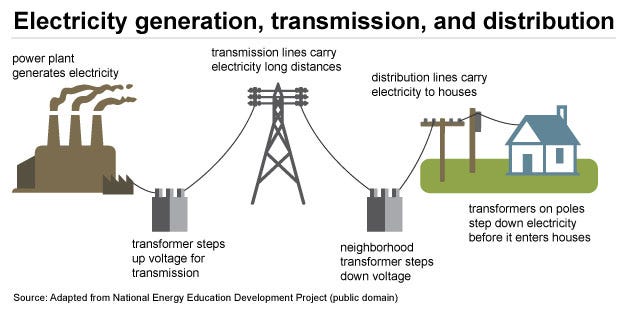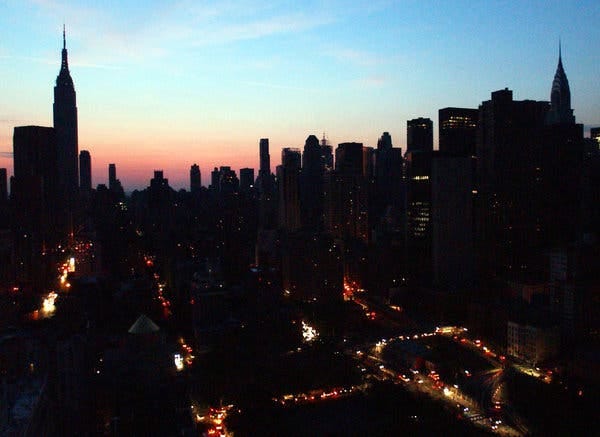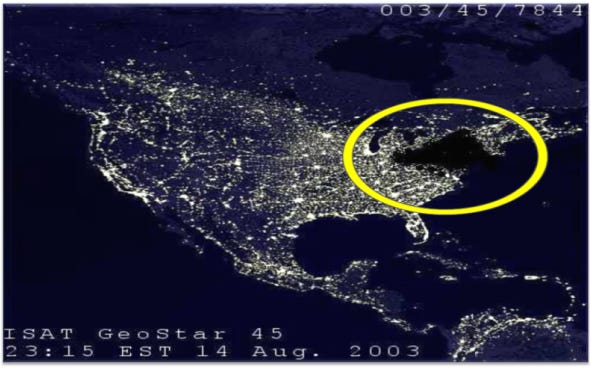Let's Talk About Grid Blackouts
What causes grid blackouts, and how can innovation improve grid reliability?
Welcome to Electrification Explained!
Did a friend send you this newsletter? Be sure to subscribe to learn about new topics in the electrification space explained in my own words through speaking with early stage startups, reading articles, asking experts, and more. New post at least once a month.
TL;DR
🌑 A blackout is a widespread loss of electricity due to a power grid failure.
⏱ The Northeast Blackout of 2003 lasted 2 days (4 days in some areas) and affected 50M people across 8 states.
💰 $6B loss in business revenue in just a few days due to the 2003 blackout.
I have been focused on learning more about the grid over these last few months, and a friend of mine recommended that I read The Grid by Gretchen Bakke. This issue of Electrification Explained is centered around a common theme of the book… when, why, and how a blackout occurs and what the impact of blackouts are. Now, I have touched on the grid a little bit in previous issues, but this one will dive a bit deeper into the history of the grid and focus on a specific event.
As a quick refresher, the image below shows how the grid moves energy from power plants all the way to your home.
These days, power generation can be decentralized meaning the energy in your home may not be coming from one specific power plant, but rather a collection of natural gas power plants, solar and wind farms, potentially nuclear power plants and a few other forms of generation.
What is a blackout?
A grid blackout, also known as a power grid failure, happens when there's a widespread loss of electrical power in an area served by a power grid. The power grid is like a network of power lines, substations, and power plants that distribute electricity to homes, businesses, and institutions.
Blackouts can be caused by quite a few things, but the most common causes are:
Equipment Failure: Sometimes, the equipment that's part of the power grid, like transformers or power lines, can fail due to age, weather conditions, or other factors.
Utility Neglect for Upkeep: All of the interconnections in the US (Eastern, Western, Electric Reliability Council of Texas (ERCOT)) have vegetation management guidelines to ensure that tree branches are routinely trimmed in order to prevent interference with transmission lines. Occasionally, utilities neglect or delay the guideline, which can lead to fires and outages.
Natural Disasters: Severe weather events such as storms, hurricanes, or earthquakes can damage power lines and substations, leading to a loss of power across a large area.
Human Error: Occasionally, mistakes made by operators or technicians can cause disruptions in the power grid.
Cyberattacks: Power grids are also vulnerable to cyberattacks, where hackers can infiltrate and disrupt the system, causing blackouts.
Gretchen Bakke’s book touches on the most notorious blackouts the US grid has ever faced, but I am going to focus specifically on the Northeast Blackout of 2003 that began in Ohio FirstEnergy’s territory.
Honestly, I had to pick my jaw up from the floor when I saw the picture above — the unavoidable darkness caused by just a few trees and a small bug in a line of code.
The groundwork for the 2003 Northeast Blackout began in 2001…
In 2001, the Energy Policy Act (EPA) was made law. The EPA allowed the Federal Energy Regulatory Commission (FERC) to separate electrical generation from electrical distribution. This created a shift in business model for utilities, as now most of their money would be made by “transporting, delivering, and metering electricity — rather than making by producing it”1.
Now, I could see why you might be questioning the relevance of the EPA to the 2003 Northeast Blackout, but stay with me here. The emergence of the EPA created financial concerns for most utilities like Ohio’s FirstEnergy. Ohio’s FirstEnergy began to cut back on certain costs that at the time were viewed as lower priority — maintenance and upkeep.
In 2002, Ohio’s FirstEnergy only completed 17% of their maintenance and repair tasks, which resulted in a backlog of almost 11k tasks to be completed in 2003. Ohio’s FirstEnergy was looking to further cut costs, so the utility decided to lay off 500 skilled workers whose jobs were focused on infrastructure upkeep. This reduction in workforce was also due to the tree-trimming schedule policy shifting from every 3 years to every 5 years. I hope now the pieces are starting to fall into place of how a few small changes led to one of the largest blackouts in US history.
Now, let’s fast forward to August 14, 2003. Walton Hills, a suburb of Ohio, experienced a warm day, and sagging power lines is expected in warmer conditions. The issue on this day was the sagging line was not just any line — it was a high-voltage line designed to go long distances particularly from power plants to urban substations. This particular sagging, high-voltage line came into contact with a tree branch (that should have already been trimmed), and the line shorted. The load shifted to the duplicate wires as it should.
It is important to note that transmission line death is not a rare occurrence — in fact, most utilities have duplicate lines ready to take the load of the damaged line. The duplicate lines serve as a back up system to prevent a cascading effect of line damage.
Coincidentally, in a different part of town a second line sagged and sure enough came into contact with a tree — the load from the shorted line shifted to the duplicate line. The duplicate lines were now carrying the loads of two different shorted lines. The additional load on the duplicate lines began to impact other lines, so out goes the third and fourth line. All of a sudden, there was a cascading effect that triggered an automatic shutdown of 15 other lines to prevent any damage. At this point, the trees were no longer a problem — the line failures were. The line failures created an imbalance in load, which resulted in overcurrent, meaning too much current on the few operating lines that had rather limited transmission capacity to carry the current.
Normally, the utility will have alarms in place that will allow them to promptly communicate with other utilities to warn them about the outage. This is where the 2003 blackout gets interesting…
Ohio’s FirstEnergy genuinely had no idea that 18 lines were down in their territory because a small software bug (not maliciously placed) halted the refresh of their reporting screens and silenced their alarms. Simultaneously, energy across the East Coast was flooding to Ohio because it seemed to not have enough current to meet demand (this was due to the outage). Ohio’s FirstEnergy started to receive calls from neighboring utilities asking what was going on, but Ohio’s FirstEnergy said everything was fine because as far as they could see, their systems were running A-OK.
As I mentioned, the current was flooding to Ohio, and then reversed direction given there was nowhere for the current to go. This was causing an extreme load imbalance, so New York islanded itself, meaning it disconnected its local grid from the greater system. Islanding itself turned out to be detrimental as well because now the supply of energy was greater than the demand. The circuits started to trip and pretty quickly New York was experiencing a blackout. It was only a 1.5 hour timeline from when the first line went down in Ohio’s FirstEnergy territory to when they were aware there was an actual problem. This lack of awareness created a cascading effect that resulted in 8 states losing power.
The role of innovation in grid resilience
There are many ways to approach grid resilience, but I believe the biggest impact on the grid will be the adoption of EVs. There will need to be an increase in capacity to accommodate for the load of 33M EVs over the next 10 years. A way to increase capacity is to leverage existing battery systems to create virtual power plants that the grid can draw from when there is a peak load. If you are paying attention to this space, you are likely seeing a lot of virtual power plant and distributed energy resource startups. Additionally, you can think about improving grid resilience by reducing energy consumption through increased efficiency, more specifically in the commercial and industrial sectors.
I have no doubt that there will need to be mass upgrades to the existing grid infrastructure, but in the meantime, there are many impactful startups that can improve grid resilience.
Grid intelligence companies to watch (varying stages):
Qilo (Chicago, IL) - AMI data to help utilities select the best energy solutions for their grid.
Leap (San Francisco, CA) - Building grid resiliency with DERs.
Virtual Peaker (Louisville, KY) - Connecting utilities and energy companies to IoT.
Gridware (Bay Area, CA) - Grid monitoring system designed to detect and predict faults.
AutoGrid (Redwood City, CA) - DERs management software; acquired by Uplight.
Camus Energy (San Francisco, CA) - Software platform anticipating and actively managing local grid constraints.
Origami Energy (Cambridge, UK) - Battery energy storage system management platform.
WeaveGrid (San Francisco, CA) - Working with utilities to accelerate electrification.
Want to read more? Check out these resources.
The Grid by Gretchen Bakke (p. 120)






Thanks for putting this together! Super important to recognize the loss of revenue from climate disasters broadly!